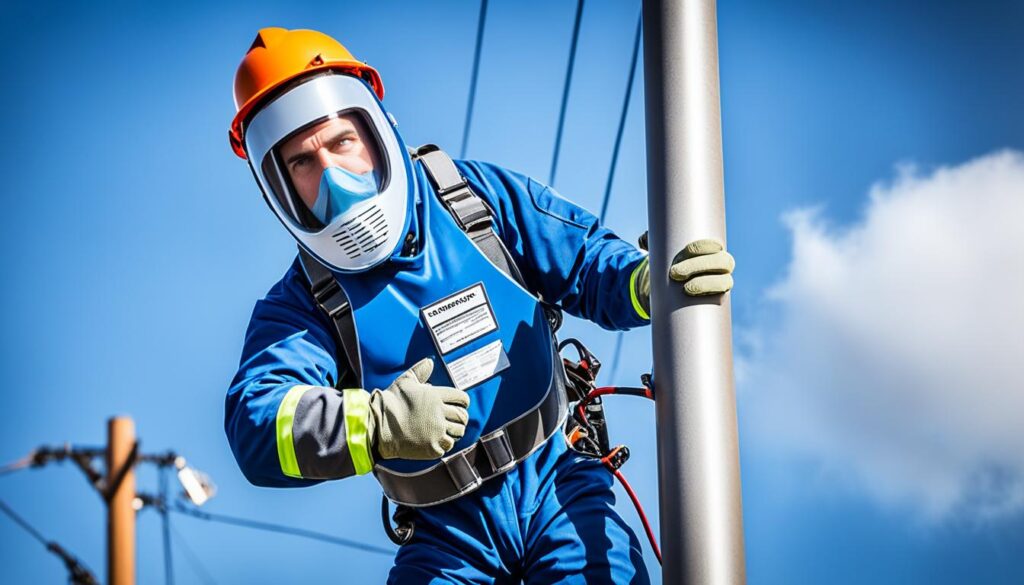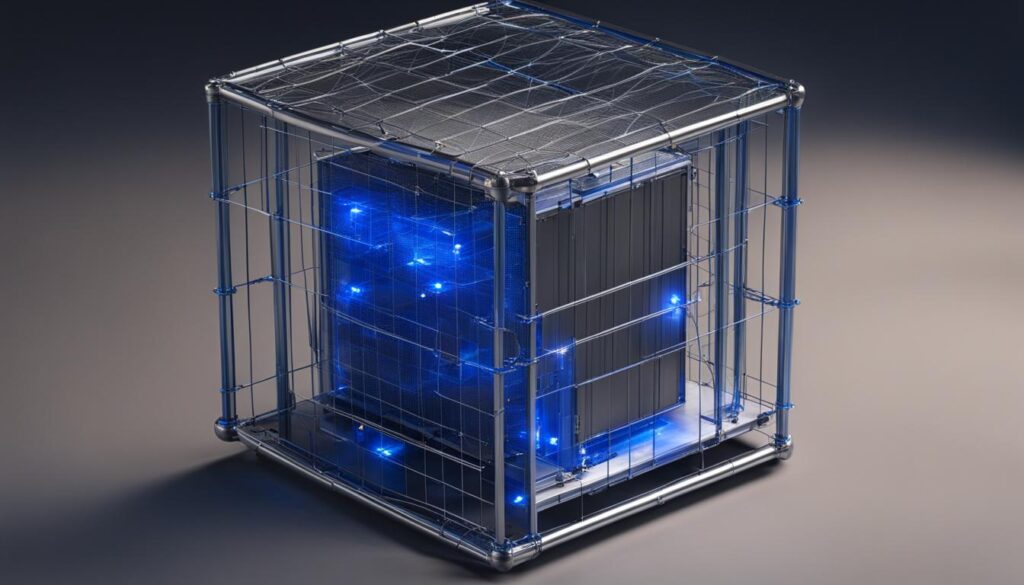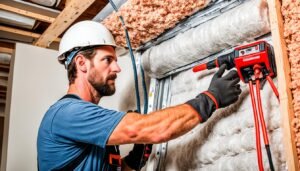Disclosure: This Post Contains Affiliate Links; We earn a commission on purchases.
EMF shielding techniques in construction are crucial for creating safer living spaces with reduced exposure to electromagnetic fields. As technology continues to advance, our daily lives are increasingly surrounded by sources of electromagnetic radiation, such as cell phone towers, Wi-Fi networks, and electrical appliances. While these technologies bring convenience and connectivity, they also raise concerns about potential health effects.
Incorporating EMF protection methods in construction projects is an effective way to mitigate the impact of electromagnetic radiation on both occupants and sensitive electronic equipment. By utilizing construction materials specifically designed for EMF shielding and implementing strategic techniques, buildings can create a shielded environment that minimizes the penetration of electromagnetic fields.
Key Takeaways:
- EMF shielding techniques in construction help reduce exposure to electromagnetic fields.
- Specialized construction materials are available for EMF shielding.
- Strategic implementation of shielding techniques can create a shielded environment.
- EMF shielding protects both occupants and electronic equipment.
- Minimizing electromagnetic field penetration promotes a safer living and working environment.
Measuring EMF Radiation and Determining the Need for Shielding.
To ensure the effectiveness of EMF shielding techniques, it is crucial to first measure the existing levels of EMF radiation in a space. By accurately assessing the radiation levels, individuals can determine whether shielding is necessary and to what extent it should be implemented. This can be achieved through the use of specialized equipment such as high frequency and low frequency radiation meters.
An EMF meter is a valuable tool for measuring electromagnetic fields and determining their intensity. It allows individuals to quantify the levels of EMF radiation emitted by various sources, including cell phone masts, Wi-Fi networks, and cordless phones. By understanding the specific levels of EMF radiation present, individuals can make informed decisions about the need for shielding.
There are several reasons why shielding may be necessary. High levels of EMF radiation can have potential adverse effects on human health, including increased risk of cancer, reproductive issues, and neurological disorders. Shielding becomes particularly important in areas where individuals spend a significant amount of time, such as bedrooms, offices, and schools.
“To determine the need for EMF shielding in a space, it is essential to measure the existing levels of EMF radiation.”
Furthermore, shielding is necessary to protect sensitive electronic equipment from the detrimental effects of EMF radiation. Without proper shielding, devices such as computers, medical equipment, and audiovisual equipment can malfunction or experience interference, leading to performance issues and potential data loss.
Measuring EMF radiation not only helps in determining the need for shielding, but it also provides a baseline for evaluating the effectiveness of implemented shielding techniques. Regular measurements can ensure that the desired reduction in EMF radiation levels is achieved and maintained over time.
Shielding Techniques for Wireless Radiation Sources.
Wireless radiation sources, such as cell phone masts, Wi-Fi networks, and cordless phones, emit electromagnetic fields that can potentially pose health risks. However, there are effective shielding techniques available to minimize exposure and create safer living spaces.
When it comes to wireless radiation shielding, a variety of specialized materials can be utilized. These include:
- Electromagnetic shielding paints: Applying paint containing conductive materials to walls and floors can help block and absorb wireless radiation.
- Window films for EMF shielding: Metal-coated window films can reflect and reduce radiation levels from external sources while still allowing natural light to enter the space.
- Shielding fabrics: Curtains woven with copper and silver can act as a barrier to wireless radiation, providing protection for individuals inside the building.
- Canopies and meshes: Installing canopies or using meshes made of conductive materials can help shield against wireless radiation, particularly in outdoor spaces.
These electromagnetic shielding materials can be applied to windows, walls, and floors to reflect and block wireless radiation, reducing its penetration into living spaces. By incorporating these shielding techniques, individuals can create an environment that minimizes their exposure to wireless radiation.
The Benefits of Wireless Radiation Shielding
Shielding wireless radiation sources offers several benefits:
“By implementing shielding techniques, individuals can decrease their exposure to wireless radiation and potentially reduce the associated health risks. This is especially important in areas with high concentrations of cell phone masts, Wi-Fi networks, and cordless phones.”
Not only does wireless radiation shielding provide physical health benefits, but it also promotes peace of mind and a sense of well-being by creating an environment that prioritizes safety and protection.
Shielding Techniques for High Voltage Lines and Electrical Equipment.
High voltage lines, transformers, and electrical panels generate both magnetic and electric fields that can be shielded using specific techniques. Shielding from these sources is crucial in construction projects to mitigate the impact of electromagnetic fields and ensure the safety of occupants and electronic equipment.
One effective method for shielding high voltage lines is through the use of magnetic shielding materials. These materials, typically made of alloys such as mu-metal or permalloy, have high permeability and can redirect and reduce magnetic field lines. By installing magnetic shields around high voltage lines, the magnetic field emissions can be significantly reduced, minimizing potential health risks.
When it comes to shielding transformers, various strategies can be employed. Magnetic shielding materials can be placed around the transformer core to redirect and contain the magnetic field. Additionally, keeping a safe distance between transformers and sensitive areas can help reduce exposure to electromagnetic fields.
Electrical panels can also emit electromagnetic fields that need to be shielded. One approach is to use electric shielding methods. Conductive paints, such as graphite-based paints or conductive metal coatings, can be applied to the interior walls of electrical panels. These coatings create a conductive surface that helps direct and ground electric fields, reducing their impact on the surrounding environment.
Another option for shielding electrical panels is the use of shielding textiles. Conductive fabrics, such as copper mesh or carbon fiber textiles, can be installed around the panels to create a barrier against electric fields. These textiles can be easily cut and shaped to fit the specific dimensions of the panels, offering a flexible and effective shielding solution.
“Proper shielding techniques for high voltage lines and electrical equipment are essential for minimizing electromagnetic field exposure and ensuring the safety of occupants and electronic devices. By implementing magnetic shielding materials and electric shielding methods, construction projects can effectively mitigate the impact of electromagnetic fields.”

| Shielding Technique | Application |
|---|---|
| Magnetic shielding materials | High voltage lines, transformers |
| Conductive paints | Electrical panels |
| Shielding textiles | Electrical panels |
Creating Faraday Cages for Enhanced Shielding.
Faraday cages are essential for effectively shielding an area from artificial electromagnetic radiation. By constructing these conductive shells, you can create a safe haven that blocks most types of EMF radiation. Faraday cages are commonly used in facilities such as laboratories, hospitals, and recording studios to protect sensitive electronic equipment from electromagnetic interference.
To construct a Faraday cage, you need to cover all surfaces of a room with grounded shielding materials. This can include conductive paint, mesh, or fabric that provides a continuous conductive surface. By ensuring proper grounding, the Faraday cage can redirect and absorb electromagnetic radiation, preventing it from reaching the interior space.
Constructing Faraday cages is a reliable method of enhancing electromagnetic radiation shielding, providing a high level of protection for both individuals and electronic devices. Whether you’re concerned about the potential health effects of electromagnetic radiation or the functionality of sensitive equipment, Faraday cages offer a practical solution.

“The concept of the Faraday cage has been instrumental in shielding electronic equipment and spaces from electromagnetic radiation. By enclosing an area with conductive materials, we can create a safe space that neutralizes external electromagnetic fields.”
Architectural Shielding Materials and Their Applications.
A wide range of architectural shielding materials are available for different applications. Whether you need to protect a residential space, office building, or medical facility, there are various options to suit your specific requirements. These materials are designed to effectively reduce the transmission of electromagnetic radiation, ensuring a safer environment for occupants and sensitive electronic equipment.
Electromagnetic Shielding Paints
Electromagnetic shielding paints provide an excellent solution for both interior and exterior shielding. These paints contain conductive materials, such as metal particles or carbon fibers, which create a barrier that reflects or absorbs electromagnetic waves. They can be applied to walls, ceilings, and other surfaces to block the penetration of electromagnetic radiation. Moreover, electromagnetic shielding paints are easy to apply and can be seamlessly integrated into any architectural design.
Shielding Meshes and Fleeces
Shielding meshes and fleeces offer versatile shielding options that can be incorporated into building materials or existing structures. These materials are typically made of metal or conductive fabric, and they form a protective barrier against electromagnetic radiation. Shielding meshes are commonly used in construction projects to create enclosures or partitions that isolate specific areas from electromagnetic fields. Similarly, shielding fleeces can be integrated into walls, floors, or ceilings to enhance the overall shielding effectiveness.
Shielding Textiles
Shielding textiles, such as net curtains made of specially produced shielding fabric, are an effective solution for shielding electromagnetic radiation entering a building through windows. These textiles are designed to significantly reduce the intensity of electromagnetic waves without compromising visibility or natural light. By installing shielding textiles on windows, you can create a more protected environment while maintaining an aesthetically pleasing interior.
Window Films for Shielding
Window films provide a transparent and conductive solution for shielding against electromagnetic radiation. These films are applied directly to the windows and effectively reflect or absorb electromagnetic waves. They are commonly used in areas with high exposure to wireless radiation, such as near cell phone towers or Wi-Fi networks. Window films not only provide excellent protection but also help maintain a comfortable interior temperature by reducing solar heat gain.
Grounding Connections
Grounding connections play a crucial role in ensuring the effectiveness of architectural shielding materials. By grounding the conductive materials, such as paints, meshes, and textiles, any excess voltage or static charge can be safely discharged into the ground. This helps maintain a stable electrical environment and prevents potential hazards associated with electromagnetic radiation.
| Architectural Shielding Material | Applications |
|---|---|
| Electromagnetic Shielding Paints | Interior and exterior shielding of walls, ceilings, and surfaces |
| Shielding Meshes and Fleeces | Incorporation into building materials or existing structures for enhanced shielding effectiveness |
| Shielding Textiles | Installation on windows to reduce electromagnetic radiation entering the building |
| Window Films for Shielding | Application on windows to reflect or absorb electromagnetic waves |
| Grounding Connections | Ensuring the safe discharge of excess voltage and static charge |
Conclusion
In conclusion, the implementation of EMF shielding techniques is of utmost importance in construction projects to create safer living spaces with reduced exposure to electromagnetic fields. By incorporating specialized materials like electromagnetic shielding paints, meshes, textiles, and window films, buildings can effectively minimize the impact of EMF radiation.
Shielding techniques for wireless radiation sources, such as cell phone masts, Wi-Fi networks, and cordless phones, along with shielding methods for high voltage lines and electrical equipment, provide additional protection against electromagnetic fields. By utilizing these techniques, occupants can enjoy a healthier environment while sensitive electronic equipment remains protected.
The benefits of EMF shielding are extensive. It not only safeguards human health and well-being but also helps preserve the functionality and longevity of electronic devices. Moreover, the construction industry plays a pivotal role in promoting EMF protection, ensuring that buildings are equipped with the necessary measures to shield against harmful radiation.
By prioritizing the importance of EMF protection in construction, we can create a future where buildings are designed and constructed with the well-being of occupants and the preservation of electronic equipment in mind, offering peace of mind and a safer living environment for all.
Source Links
- https://www.home-biology.com/electromagnetic-shielding-guide/how-to-shield-your-house-from-eleectromagnetic-fields
- https://www.radiansa.com/en/electromagnetic-radiation/architectural-shielding.htm
- https://www.compeng.com.au/emf-shielding/

Subscribe to Our Newsletter










